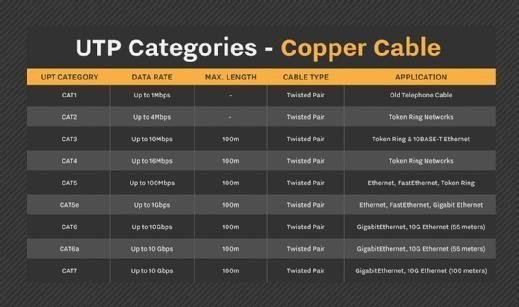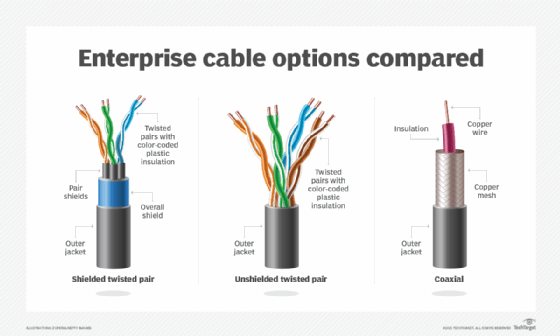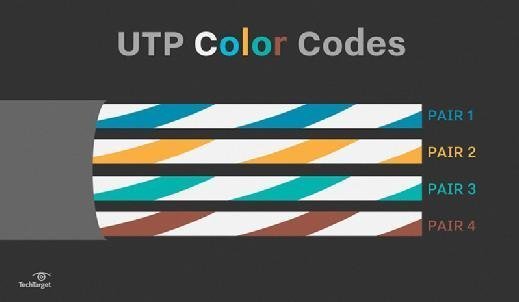near-end crosstalk (NEXT)
What is near-end crosstalk (NEXT)?
Near-end crosstalk (NEXT) is an error condition that can occur when connectors are attached to twisted pair cabling. NEXT is usually caused by crossed or crushed wire pairs. The error condition does not require that the wires be crushed so much as the conductors inside become exposed.
Two conductors only need to be close enough so that the radiating signal from one of the wires can interfere with the signal traveling on the other. Most medium- to high-end cable testers are capable of testing for NEXT errors.
When signals moving through adjacent pairs of wire in a twisted pair copper cabling interfere with each other, it leads to crosstalk. Near-end crosstalk occurs when a signal on one pair of wires is picked up by an adjacent pair of wires. It is the portion of the transmitted signal that's electromagnetically coupled back into the received signal causing interference.
Near-end crosstalk measures the signal coupled from one pair of wires to another and refers to the ability of twisted wire cabling to reject crosstalk. It is called near end because it measures crosstalk pairs of wire at the near (same) end of the circuit, link or channel where the signal is sourced. The cabling pair causing the interference is the disturbing pair, while the pair experiencing the interference is the disturbed pair.
Different kinds of twisted pair cables have different NEXT values at the same frequency. For instance, at 100 megahertz (MHz), a Cat6 and Cat5 cable have a NEXT value of 44.3 decibels and 35.3 dB, respectively. The twisted rate on each pair optimizes for crosstalk performance, with different twists for each pair preventing them from picking up crosstalk from other pairs.

How is near-end crosstalk measured?
NEXT is expressed in dB. A higher dB indicates less crosstalk is received by the disturbed link. Crosstalk varies with transmission frequency, with higher frequencies creating more interference. So, a cable might have a NEXT value of 40 dB at 50 MHz and 30 dB at 100 MHz.
This indicates that NEXT performance is better at lower frequencies.
Since NEXT varies depending on frequency, it's important to measure it across a range of frequencies -- in total:
- Higher frequencies mean more crosstalk.
- Lower frequencies mean less crosstalk.
- Lower NEXT means more crosstalk.
- Higher NEXT means less crosstalk.
Higher NEXT is preferred to lower NEXT.
Types of near-end crosstalk
Pair-to-pair NEXT
Pair-to-pair NEXT occurs between adjacent wire pairs in a twisted pair cable. In a four-pair unshielded twisted pair cable, there are six possible NEXT values. Averaging these values is not particularly useful since every pair generates crosstalk with every other pair.
Power Sum NEXT (PSNEXT)
This measures the total crosstalk between one wire pair and all its neighbors. In a four-pair cable, each pair is affected by the other three pairs, and PSNEXT sums up their crosstalk. It is an important value, especially when all four pairs are transmitting signals in a network -- e.g., in high-speed gigabit Ethernet or Asynchronous Transfer Mode networks.
Power Sum attenuation-to-crosstalk ratio, near end (PSACRN)
PSACRN indicates the difference between the attenuation of each pair and the combined crosstalk received from the other three pairs -- i.e., how strong the received signals are in relation to the noise in the cable. Higher PSACRN indicates better performance.

Best practices to minimize crosstalk
In twisted pair cabling, the twist helps cancel crosstalk. So, when wires are not tightly twisted, crosstalk happens. To prevent crosstalk, wire pairs in a Cat5e cable should not be untwisted more than 0.5 inches and not more than 0.375 inches for Cat6 cables.
Crosstalk can also happen when cables are poorly designed or installed. This can be especially problematic with 10Base-T and 100BASE-TX networks.
Balanced twisted wire cable can help guard against crosstalk by twisting the wires together and creating more space between them. With such a cable, it's important to maintain the design performance of connecting hardware by ensuring it terminates in accordance with the manufacturer's instructions.
The amount of untwist between pairs should be kept to a minimum, and the pair twists should be maintained as close as possible to termination.

How to troubleshoot near-end crosstalk failures
Despite every precaution, NEXT failures can occur. Troubleshooting is easiest with a field tester with a time domain feature that can pinpoint the exact fault.
In case of a NEXT failure, the first step is to determine the end at which the failure occurred. Based on this, the connections at that end should be checked and either re-terminated or replaced, as appropriate.
If this is not the problem, the presence of lower category patch cords may be the root cause. Split pairs are also a possible cause, and they can be automatically identified with the field tester's wiremap function.
Other possible causes of NEXT failures and potential solutions include the following:
- Female couples. Avoid using in a data installation.
- Cable not long enough. Don't add another cable; replace the existing cable with a cable of the required length.
- Inappropriate test selection. Set performance requirements as per the installation.
If none of these solutions work, it is best to contact the system designer.








